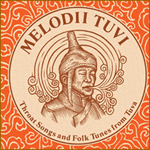|
|
 |
Dusted Reviews
Artist: V/A Album: Melodii Tuvi: Throat Songs and Folk Tunes from Tuva Label: Dust-to-Digital Review date: Jan. 9, 2008 |

|
|
|
 |
With origins in the shamanic paradigms of an ancient sheep-herding culture, the throat singing of Tuva is a powerful – and living – musical tradition that utilizes fully the rich overtone possibilities of the human voice. Imitating the sounds of the natural world (animals, birds, insects; wind and waters) to tell stories and express a sense of place, Tuvan khoomei singers can generate low drones, rhythmic pulses, and whistling, ringing countermelodies – all at the same time. Melodii Tuvi presents some remarkable recordings originally released in Russia in 1969, offering a rare opportunity to hear what some of this music – along with a sampling of hypnotic and powerful instrumental pieces – sounded like before the world music boom of the 1980s and ’90s brought it to a wider world of movie soundtracks and cross-cultural collaborations.
The collection starts at a definite peak, with a generous sampling from master singer Oorjak Hunashtaar-ool (1932-1993.) Singing solo or accompanying himself on doshpulur – a kind of lute – Hunashtaar-ool demonstrates a transcendent ability to weave his many voices into a flowing, unfolding musical experience, with subtle changes in tempo and rhythmic emphasis adding a compelling dimension to the all-pervasive throat and mouth tones: the resonant low drone; a burry, growling middle voice similar to that of bluesman Howlin’ Wolf or South African groaner Mahlathini; hollow and sky-reaching high harmonics that dip and, ultimately, soar.
It might at first prove difficult to get beyond Hunashtaar-ools’ brilliant recital and into the rest of the disc, but doing so provides plenty of rewards. There are other voices represented; for instance, that of M. Dakpay, who combines stirring, heroic vocal lines with the expressive bowing of his own igil ( two-stringed fiddle.) Other tracks offer chances to hear some solo igil, and there are tastes of the cello-like bysaanchi and the pulsing resonance of the other-worldly temir-khomus (jaw harp.)
Beyond the quality of the music itself, the collection has much to recommend it. The period (late-’60s) quality of the recording is thick, robust, and very present, keeping, it seems, with the very best techniques for recording European classical music extant during the golden age of analog. The liner notes are clear and informative, offering biographical information, cultural and geographical contexts for the music, and even an analysis of the physiology behind overtone singing. As a whole, Melodii Tuvi reflects nicely the ideals that the Dust-to-Digital label brings to most of their field- recorded collections, making for yet another anthology that creates an engaging sense of intimacy between music and listener.
By Kevin Macneil Brown
|







